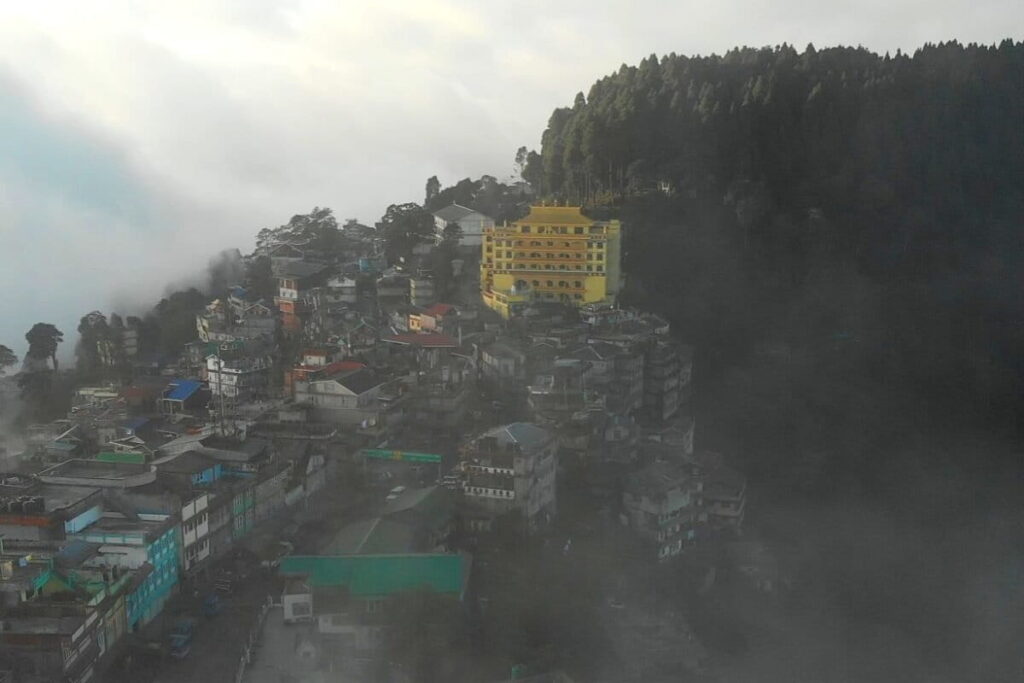Why This Darjeeling Town Is Getting Known As “A Leopard’s Trail”
Oct 28, 2025 | Pratirodh Bureau
An aerial view of Sukhia Pokhri town and surrounding forests, which were once barren. Rampant firewood collection had stripped the tree cover. A subsequent shift to LPG and electricity allowed the forests to regenerate, and wildlife to return (Image by Aditya Rai)
- Sukhia Pokhri in the Darjeeling hills has shifted from being known for its cold, foggy winters to being a place where leopard sightings are a routine part of life.
- Regeneration of surrounding forests, driven by reduced firewood use and improved livelihoods, has brought wildlife, including leopards, closer to the town’s edges.
- While livestock losses are minimal, making coexistence more tolerable, growing tourism and changes in prey availability could quickly tip this balance toward conflict.
In West Bengal’s Sukhia Pokhri in Darjeeling hills, spotting a leopard on the road doesn’t make the news anymore. The headlights of vehicles passing through the town pick up a flash of pale fur, a tail curling low, and two unblinking eyes. The leopard slowly slips into the dark, silently all the way. For decades, this small town was known for its biting winters and endless fog. Outsiders had a typical question for local residents: “How do you live there? It’s always so cold and gloomy!” Now the refrain has shifted: “How do you live with the leopards?”

For older residents, the routine leopard sightings are a startling transformation. Many had only ever heard second-hand stories of leopard sightings and witnessed livestock predation incidents.
Sukhia Pokhri back then, was ringed by barren grasslands, with the tree line far from homes. Firewood collected from the surrounding forests was the primary fuel for cooking and heating, and heavy extraction stripped the nearby slopes of tree cover. Over the years, however, improved road access, rising incomes, and stricter enforcement of bans on fuelwood extraction shifted households to LPG and electricity. The forests regenerated, creeping right up to the backyards of houses on the town’s edge. And with the trees came the wildlife.
Elusive leopards have adapted with remarkable ease to these human-dominated landscapes. They skirt houses, pad along farmland, and often use motorable roads as travel corridors.
This however isn’t just Sukhia Pokhri’s story. Across the Darjeeling hills, drivers and pedestrians have been sharing information about leopard sightings — sometimes tinged with awe, sometimes with unease. While Sukhia Pokhri has been spared from tragedies such as human casualties so far, nearby towns have not: there have been reports of tea garden workers being mauled by leopards. The cats have also been reported entering homes or found trapped in fences.
Sukhia Pokhri functions as a commercial and administrative hub, drawing families from rural villages for its schools, offices, and life of convenience. Livestock rearing is rare here now and with only a few goats or cattle to lose, leopards prey on pet and stray dogs.
But the balance is fragile. If stray dogs — currently a key leopard prey — are removed, as previously proposed in cities like Delhi, these predators may turn to other targets. A single fatal encounter could flip public sentiment overnight, as has happened in parts of Maharashtra and Uttarakhand.
Risks of unmanaged tourism
Meanwhile, the leopard’s visibility in this part of Darjeeling has attracted wildlife enthusiasts and tour operators. But without clear guidelines, this could harm the leopards that the visitors come to admire. Also, crowding around leopard sightings, and other actions just to get a better look at the animal, can actually harm the animal by altering its behaviour and increase the risk of collisions.

On paper, wildlife tourism can foster appreciation for species like the leopard. Yet in practice, the benefits often bypass the people who live alongside them. Large operators, many from outside the region, take the bulk of profits, while local residents get physically demanding, low-paid jobs. The costs of coexistence — fear for children’s safety, altered routines and the occasional loss of life, remain entirely theirs.
The burden of managing human–leopard interactions falls largely on an under-resourced forest department. Frontline staff, often with minimal training and equipment, are expected to handle everything from calming angry crowds after a livestock kill to capturing leopards at personal risk, without adequate safety gear or health insurance.
A recent study points out a striking paradox: the world’s most biodiverse regions often spend the least on protecting their wildlife. Countries that harbour the richest diversity of species typically have limited conservation budgets compared to wealthier nations with lower biodiversity. This mismatch means that areas facing the greatest human–wildlife interaction challenges, such as the Himalayas or other biodiversity hotspots, often lack the financial resources to invest in research, monitoring, and conflict mitigation, even as pressures on ecosystems and communities intensify.
Reliable population estimation studies using camera traps, genetic sampling, and other monitoring tools can be vital for planning future management. Knowing how many leopards use the forests around towns, such as Sukhia Pokhri, their movement patterns, and preferred hunting grounds allows authorities to anticipate potential conflict zones, plan targeted awareness programmes, and deploy mitigation measures, including road signage and speed restrictions in high-use areas. Regularly updated data can also help track whether changes in prey numbers or habitat are pushing leopards closer to settlements, enabling proactive interventions before tensions escalate.
Camera trap studies in Darjeeling have revealed that mammals are photographed just as frequently in human-dominated landscapes as they are inside protected forests, confirming their regular presence near settlements. Several ecological studies have also shown that proximity to motorable roads and human habitation can increase leopard capture rates, highlighting how these predators navigate and utilise shared spaces — sometimes in closer proximity to people than most residents realise.
If unmanaged, tourism could accelerate the very conflicts it claims to offset. For the Darjeeling hills, the challenge is clear: set and enforce ethical wildlife-viewing rules, ensure tourism benefits are shared fairly, and maintain open dialogue among residents, conservationists, and authorities.
The leopard’s trail through Sukhia Pokhri is still one of wonder, and whether it stays that way will depend on choices made now. Without thoughtful management, this story could turn from coexistence to confrontation and the loss would be felt on both sides. So the question now is, “How can they continue living with the leopards?”
(Published under Creative Commons from Mongabay India)
